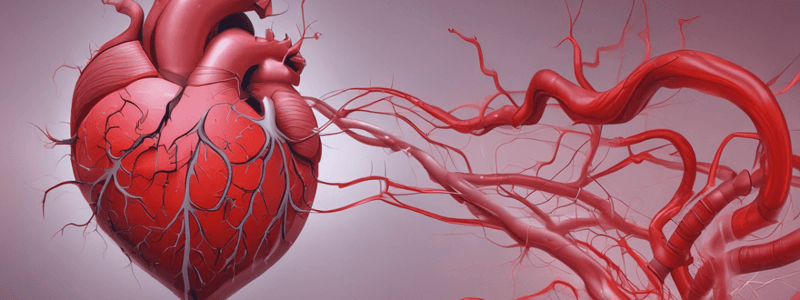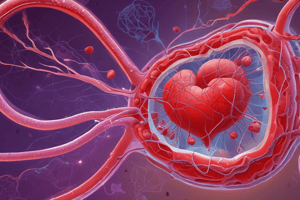Podcast
Questions and Answers
What is the primary difference between STEACS and NSTEACS?
What is the primary difference between STEACS and NSTEACS?
The degree of obstruction and necrosis
What is the criterion to differentiate between UA and NSTEMI?
What is the criterion to differentiate between UA and NSTEMI?
Troponin levels
What is the consequence of myocardial ischemia in terms of cell death?
What is the consequence of myocardial ischemia in terms of cell death?
Apoptosis and necrosis
What is the term for the type of myocardial infarction characterized by ST-elevation or new left bundle branch block (LBBB)?
What is the term for the type of myocardial infarction characterized by ST-elevation or new left bundle branch block (LBBB)?
What is the cause of Non-ST-elevation ACS (NSTEACS)?
What is the cause of Non-ST-elevation ACS (NSTEACS)?
What is the consequence of myocardial ischemia in terms of cardiac function?
What is the consequence of myocardial ischemia in terms of cardiac function?
What is the Sgarbossa criteria used for?
What is the Sgarbossa criteria used for?
What is the term for the type of myocardial infarction characterized by T-wave inversion and/or ST depression?
What is the term for the type of myocardial infarction characterized by T-wave inversion and/or ST depression?
What is the consequence of myocardial ischemia in terms of arrhythmia?
What is the consequence of myocardial ischemia in terms of arrhythmia?
What are some non-ACS causes of elevated cardiac troponin (cTn)?
What are some non-ACS causes of elevated cardiac troponin (cTn)?
What are the symptoms of acute coronary syndromes?
What are the symptoms of acute coronary syndromes?
What is silent ischemia?
What is silent ischemia?
Which populations are at risk for silent ischemia?
Which populations are at risk for silent ischemia?
What are the non-modifiable risk factors for acute coronary syndromes?
What are the non-modifiable risk factors for acute coronary syndromes?
What are the modifiable risk factors for acute coronary syndromes?
What are the modifiable risk factors for acute coronary syndromes?
What are the contributing factors to acute coronary syndromes?
What are the contributing factors to acute coronary syndromes?
What are the ischemic cardiovascular causes of acute coronary syndromes?
What are the ischemic cardiovascular causes of acute coronary syndromes?
What are the non-cardiovascular causes of acute coronary syndromes?
What are the non-cardiovascular causes of acute coronary syndromes?
What is the importance of early access to a defibrillator in acute coronary syndromes?
What is the importance of early access to a defibrillator in acute coronary syndromes?
What is the recommended initial treatment for acute coronary syndromes?
What is the recommended initial treatment for acute coronary syndromes?
What is the goal of prehospital treatment for chest pain?
What is the goal of prehospital treatment for chest pain?
What is the recommended timeframe for performing an ECG in acute chest pain management?
What is the recommended timeframe for performing an ECG in acute chest pain management?
scarbossa criteria
scarbossa criteria
STEACS management
STEACS management
Study Notes
Acute Coronary Syndromes (ACS)
- ACS includes ST-elevation ACS (STEACS) and Non-ST-elevation ACS (NSTEACS)
- STEACS is characterized by ST elevation or new left bundle branch block (LBBB)
- NSTEACS is caused by a partial occlusion of the coronary artery, resulting in T-wave inversion and/or ST depression
Terminology
- All ACS types have a similar presentation and result from plaque disruption and thrombus formation
- The primary difference between ACS types is the degree of obstruction and necrosis
Signs and Consequences of STEACS
- Signs of STEACS in LBBB: Sgarbossa
- Consequences of myocardial ischemia: cell death (apoptosis and necrosis), pump failure (impairment of myocardial contraction and relaxation), arrhythmia, and aortic dissection
Non-ACS Causes of Cardiac Troponin (cTn) Elevation
- Stroke
- Sepsis
- Hypoxia
- Pulmonary embolism (PE)
Presentation
- Chest pain that may radiate to the left arm, jaw, back, and SOB/dyspnea
- Episodes of ischemia in the absence of chest pain, presenting with anginal equivalents
- Silent ischemia is more common in specific populations, including diabetics, women, women with heart failure, hypertension, and chronic renal disease/end-stage renal disease
Risk Factors
- Non-modifiable: Family history, age, male sex
- Modifiable: Smoking, hypertension, diabetes, dyslipidemia, obesity, obstructive sleep apnea
- Contributing factors: Sedentary lifestyle, stress, depression
- Obstetric history: Placental abruption, stillbirth, hypertensive disorders, gestational diabetes, preterm birth
Differential Diagnosis
- Ischemic CV causes: ACS, stable angina, severe aortic stenosis, tachyarrhythmia
- Non-CV causes: Gastrointestinal, musculoskeletal, pulmonary, herpes zoster
- Non-ischemic CV causes: Aortic dissection, expanding aortic aneurysm, pulmonary embolism, peri/myocarditis
Acute Management of Chest Pain
- Early access to a defibrillator prevents sudden cardiac death
- Aspirin (300mg) should be given early
- 12-lead ECG should be taken en route and transmitted to a medical facility
- Pre-hospital treatment (including fibrinolysis) should be facilitated
- On arrival to the hospital: ECG within 10 minutes, continuous ECG monitoring, IV access, aspirin, pain relief, blood tests, and chest X-ray, oxygen therapy, and SpO2 monitoring
Studying That Suits You
Use AI to generate personalized quizzes and flashcards to suit your learning preferences.
Related Documents
Description
This quiz covers the concepts of ST-elevation acute coronary syndrome (STEACS) and ST-elevation myocardial infarction (STEMI) in relation to coronary artery occlusion.




